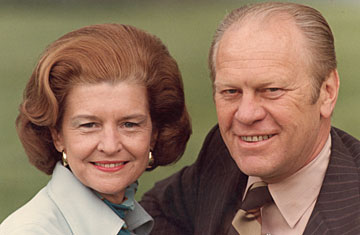
Betty Ford and her husband, President Gerald Ford, are shown in a 1976 photo. The former First Lady, who brought her struggles with alcoholism and breast cancer into the public spotlight, died July 8, 2011, at 93
(2 of 4)
Betty Ford never got to prep for the role. She hadn't slogged through a national campaign, hadn't had months or years to envision herself as Mrs. Leader of the Free World. Her husband's election as House minority leader in 1965 meant a grueling work and travel schedule that left her home alone much of the time, raising four children and maintaining as much of a sense of normality as Washington life allowed. She was actually heading out of politics before fate threw her deeper in: the toll of de facto single motherhood, along with chronic pain from a pinched nerve, left her mental and physical health sufficiently fragile that Gerald wasn't going to run for Congress again after 1974. That intention somersaulted when Spiro Agnew resigned the vice presidency in disgrace and Ford was drafted as Nixon's Vice President in October 1973. Ten months later, Betty Ford was First Lady.
In her 1978 autobiography The Times of My Life, Ford described her vault into the center ring. "The point is I am an ordinary woman who was called onstage at an extraordinary time. I was no different once I became First Lady than I had been before. But, through an accident of history, I had become interesting to people." When she held the Bible for her husband's swearing-in, she said later, "I really felt like I was taking that oath too."
Gerald Ford was a wise and good man but uncommonly common in his manner for a President; this made Betty's colorful character all the more apparent. She was the one who liked to tell off-color jokes, which she'd have to explain to him. She was First Mama on her CB radio; she made a cameo on The Mary Tyler Moore Show; she wore pantsuits and lobbied her husband to name a woman to his Cabinet. (Which he did: Carla Hills, his Housing Secretary. "I'm working on getting a woman on the Supreme Court as soon as possible," she noted.) She was named by TIME one of 12 Women of the Year in 1975. "I'm the only First Lady to ever have a march organized against her," she bragged after a choir of women dressed in black gathered in front of the White House to chant their disapproval of her lobbying for the ERA. But by and large, her popularity grew faster than the controversy she generated. She could go for a walk on a beautiful day in Georgetown, and people would stop to give her a present; a florist would run out with a bouquet. "I think they like to see me as a normal human being, doing the same thing they are doing," she said then. "Betty's Husband for President" read buttons during the 1976 presidential campaign.
She knew that some of her predecessors felt trapped by the White House. "It could be considered a goldfish bowl or a gilded cage," she said in an interview with TIME in late 1975. "But I made up my mind that I wouldn't let it be that way. I would go ahead and live my life the way I normally would. I've done it. I'm having fun."
